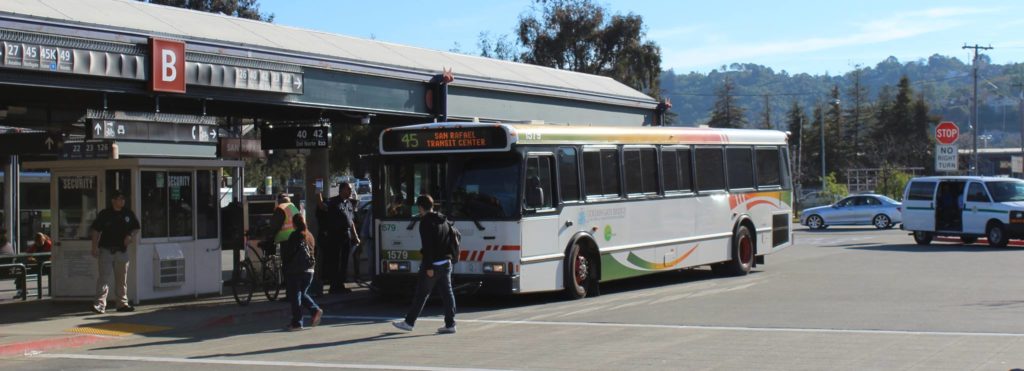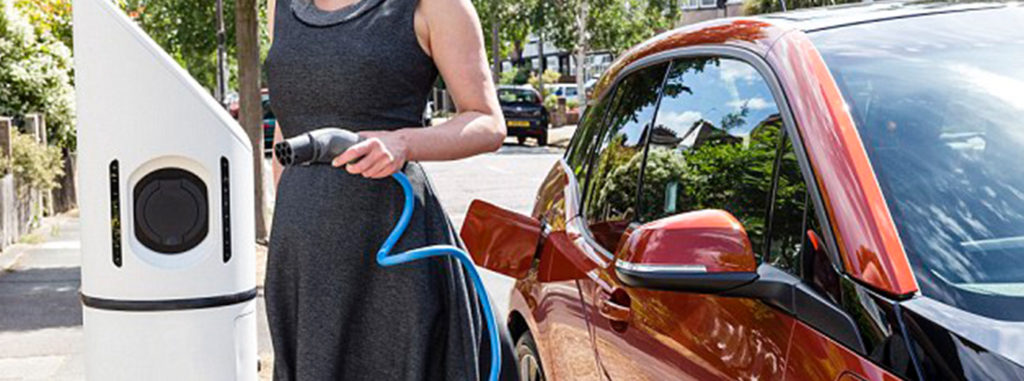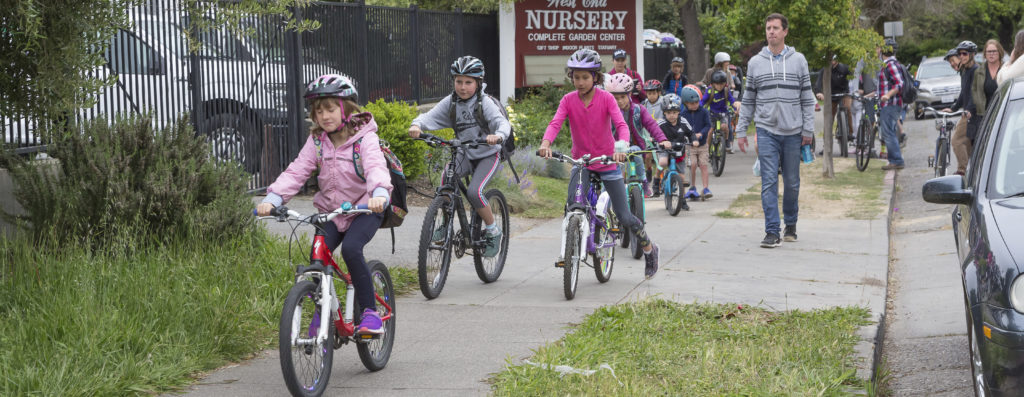38% of potential reductions
More than 60% of San Rafael’s community emissions comes from transportation. While improvements in fuel efficiency have driven emissions down over the past several years, vehicle miles traveled starting and/or ending in San Rafael have gone up. And despite improvements in the bicycle and pedestrian network and public information campaigns, there hasn’t been much increase in people taking transit, carpooling, biking or walking. If there was one area you could really make a difference it’s in Transportation!
THE TOP 5 THINGS YOU CAN DO
1. Bike, walk or take transit whenever possible.

- Marin Commutes has cool incentives and tips
- Afraid of getting stuck? Emergency Ride Home is Free in Marin!
- Visit 511.org to plan your trips.
2. Drive an all-electric or plug-in hybrid vehicle.

Not sure if an electric car is right for you?
Need help getting started?
- Get started with electric vehicles. Everything you need to know.
- How can I find charging stations?
- Financing for electric vehicles
3. Shut your car off when waiting in line at the ATM or school pick up/drop off lane.

8 Reasons to Not Idle Your Car
4. Walk or bike to school.

Safe Routes to School
Start a Walk n Roll Program at your School
Great products abound and they are cheaper to run, plus little-to-no maintenance!
Want to learn more about all your options in a fun, group setting? Check out these classes and programs!
What is the City of San Rafael Going to Do to Help?
The City will develop a Zero Emission Vehicle Plan with a goal of 25% of passenger vehicles in San Rafael to be zero emission vehicles (ZEVs), including plug-in electric vehicles (EVs) and hydrogen fuel cell electric vehicles, by 2030.
The following actions will be incorporated into the plan where feasible:
- Provide free parking for ZEVs at City parking lots and metered parking spaces.
- Provide wayfinding signage to public EV chargers.
- Work with PG&E and other entities to identify multi-family and workplace charging sites appropriate for available incentive programs, such as EV Charge Network.
- Participate in a countywide effort by MCE, PG&E and others to provide rebates for new or used electric vehicles and/or charging stations.
- Pursue opportunities to expand the City’s EV charging network through innovative programs, such as installing chargers at existing streetlight locations.
- Require new and remodeled commercial and multi-family projects to install a minimum number of electric vehicle chargers for use by employees, customers, and residents.
- Require new and remodeled single-family and multi-family projects to install electrical service and conduits for potential electric vehicle use.
- Consider requiring new and remodeled gas stations to provide EV fast chargers and hydrogen fueling stations.
- Participate in regional efforts and grant programs to encourage widespread availability of EV charging stations.
- Target policies to support ZEV adoption, including used vehicles, in low income and disadvantaged communities.
- Participate in programs to promote EV adoption, including "Drive an EV" events and other media and outreach campaigns.
- Encourage or require, as practicable, ride hailing and delivery service companies to utilize zero emission vehicles.
- Promote adoption of electric bicycles, scooters and motorcycles.
The City will encourage bicycling as an alternative to vehicular travel through outreach channels and partner agencies. Establish and maintain a system of bicycle facilities that are consistent with the City’s Bicycle and Master Pedestrian Plan and Complete Streets policies.
- Provide bicycle racks and lockers for public use.
- Participate in a bike share program.
The City will encourage walking as an alternative to vehicular travel through outreach channels and partner agencies. Establish and maintain a system of pedestrian facilities that are consistent with the City’s Bicycle and Pedestrian Master Plan and Complete Streets policies.
Continue to support the Safe Routes to School Program and strive to increase bicycling, walking, carpooling, and taking public transit to school.
- Promote school and student participation.
- Identify issues associated with unsafe bicycle and pedestrian facilities between neighborhoods and schools, apply for Safe Routes to School grants, and execute plans to improve pedestrian and bicycle facilities.
Support and promote public transit by taking the following actions:
- Work with Marin Transit and Golden Gate Transit to maximize ridership through expansion and/or improvement of transit routes and schedules.
- Work with SMART, TAM, employers and others to provide first and last mile programs to maximize utilization of the train, including shuttle buses.
- Support the development of an attractive and efficient multi-modal transit center and provide safe routes to the transit center that encourage bicycle and pedestrian connections.
- Support a “Yellow School Bus” program and student use of regular transit to reduce school traffic.
- Encourage transit providers, including school buses, to use renewable diesel as a transition fuel and to purchase electric buses whenever replacing existing buses.
Reduce vehicle miles traveled commuting to work through the following actions:
- Work with the Transportation Authority of Marin, the Metropolitan Transportation Commission, and the Bay Area Air Quality Management District (BAAQMD) to promote transportation demand programs to local employers, including rideshare matching programs, vanpool incentive programs, emergency ride home programs, telecommuting, transit use discounts and subsidies, showers and changing facilities, bicycle racks and lockers, and other incentives to use transportation other than single occupant vehicles.
- Update the City's Trip Reduction Ordinance to reflect the most recent BAAQMD regulations and to increase the number of employers subject to the ordinance.
- Embark on a behavior change and educational campaign to encourage employees to reduce vehicle trips.
Promote a walkable city by reducing parking requirements wherever feasible. Allow new development in the Downtown area to reduce minimum parking requirements by 20 percent from current levels. Elsewhere, reduce parking requirements based on robust transportation demand programs and proximity and frequency of transit services. Encourage unbundling of parking costs.
- Implement signal synchronization to minimize wait times at traffic lights and to reduce congestion through increased traffic flow.
- Utilize intelligent traffic management systems to improve traffic flow and guide vehicles to available parking.
- Encourage drivers and autonomous vehicles to limit vehicle idling through implementing behavior change and engagement campaigns.
- Investigate adopting an ordinance to regulate idling beyond State requirements.
Prioritize infill, higher density, transit-oriented, and mixed-use development.
Encourage the use of electric landscape equipment instead of gasoline-powered equipment through engagement campaigns.
Purchase or lease zero-emission vehicles for the City fleet whenever feasible, and when not, the most fuel-efficient models available. Promote City adoption and procurement of zero-emission vehicles and charging infrastructure to the public.
Use low-carbon fuel such as renewable diesel as a transition fuel in the City's fleet and encourage the City's service providers to do the same, until vehicles are replaced with zero-emissions vehicles.
Continue to provide City employees with incentives and/or reduce barriers to use alternatives to single occupant auto commuting, such as transit use discounts and subsidies, bicycle facilities, showers and changing facilities, ridesharing services, vanpools, emergency ride home service, flexible schedules, and telecommuting when practicable.
Replace gas-powered leaf blowers and other landscape equipment with electric models.

